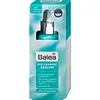Balea 5v1 BB Cream Versus Balea Niacinamide Serum
What's inside
What's inside
 Key Ingredients
Key Ingredients

 Benefits
Benefits

 Concerns
Concerns

No concerns
 Ingredients Side-by-side
Ingredients Side-by-side

Water
Skin ConditioningGlycerin
HumectantTalc
AbrasiveEthylhexyl Salicylate
UV AbsorberC12-15 Alkyl Benzoate
AntimicrobialDibutyl Adipate
EmollientCetearyl Alcohol
EmollientButyl Methoxydibenzoylmethane
UV AbsorberCI 77891
Cosmetic ColorantPolyglyceryl-6 Stearate
EmollientCetearyl Isononanoate
EmollientHydrogenated Coco-Glycerides
EmollientMyristyl Myristate
EmollientSodium Phenylbenzimidazole Sulfonate
UV AbsorberPrunus Persica Kernel Oil
EmollientAloe Barbadensis Leaf Juice
Skin ConditioningGlyceryl Stearate
EmollientTocopheryl Acetate
AntioxidantBis-Ethylhexyloxyphenol Methoxyphenyl Triazine
Skin ConditioningEthylhexyl Triazone
UV AbsorberXanthan Gum
EmulsifyingPolyglyceryl-6 Behenate
Emulsion StabilisingParfum
MaskingDisodium EDTA
Hydroxyacetophenone
AntioxidantPhenoxyethanol
PreservativeLinalool
PerfumingAlpha-Isomethyl Ionone
PerfumingLimonene
PerfumingCI 77492
Cosmetic ColorantCI 77491
Cosmetic ColorantCI 77499
Cosmetic ColorantWater, Glycerin, Talc, Ethylhexyl Salicylate, C12-15 Alkyl Benzoate, Dibutyl Adipate, Cetearyl Alcohol, Butyl Methoxydibenzoylmethane, CI 77891, Polyglyceryl-6 Stearate, Cetearyl Isononanoate, Hydrogenated Coco-Glycerides, Myristyl Myristate, Sodium Phenylbenzimidazole Sulfonate, Prunus Persica Kernel Oil, Aloe Barbadensis Leaf Juice, Glyceryl Stearate, Tocopheryl Acetate, Bis-Ethylhexyloxyphenol Methoxyphenyl Triazine, Ethylhexyl Triazone, Xanthan Gum, Polyglyceryl-6 Behenate, Parfum, Disodium EDTA, Hydroxyacetophenone, Phenoxyethanol, Linalool, Alpha-Isomethyl Ionone, Limonene, CI 77492, CI 77491, CI 77499
Water
Skin ConditioningNiacinamide
SmoothingGlycerin
HumectantPentylene Glycol
Skin ConditioningAloe Barbadensis Leaf Juice
Skin ConditioningZinc PCA
HumectantPanthenol
Skin ConditioningPhenoxyethanol
PreservativeCellulose Gum
Emulsion StabilisingAllantoin
Skin ConditioningSodium Benzoate
MaskingCitric Acid
BufferingXanthan Gum
EmulsifyingEthylhexylglycerin
Skin ConditioningTrisodium Ethylenediamine Disuccinate
Sodium Hyaluronate
Humectant
 Reviews
Reviews

Ingredients Explained
These ingredients are found in both products.
Ingredients higher up in an ingredient list are typically present in a larger amount.
Aloe Barbadensis Leaf Juice comes from leaves of the aloe plant. Aloe Barbadensis Leaf Juice is best known for helping to soothe sunburns. It is also anti-inflammatory, moisturizing, antiseptic, and can help heal wounds.
Aloe is packed with good stuff including Vitamins A, C, and E. These vitamins are antioxidants, which help fight free-radicals and the damage they may cause. Free-radicals are molecules that may damage your skin cells, such as pollution.
Aloe Barbadensis Leaf Juice also contains sugars. These sugars come in the form of monosaccharides and polysaccharides, folic acid, and choline. These sugars are able to help bind moisture to skin.
It also contains minerals such as calcium, 12 anthraquinones, fatty acids, amino acids, and Vitamin B12.
Learn more about Aloe Barbadensis Leaf JuiceGlycerin is already naturally found in your skin. It helps moisturize and protect your skin.
A study from 2016 found glycerin to be more effective as a humectant than AHAs and hyaluronic acid.
As a humectant, it helps the skin stay hydrated by pulling moisture to your skin. The low molecular weight of glycerin allows it to pull moisture into the deeper layers of your skin.
Hydrated skin improves your skin barrier; Your skin barrier helps protect against irritants and bacteria.
Glycerin has also been found to have antimicrobial and antiviral properties. Due to these properties, glycerin is often used in wound and burn treatments.
In cosmetics, glycerin is usually derived from plants such as soybean or palm. However, it can also be sourced from animals, such as tallow or animal fat.
This ingredient is organic, colorless, odorless, and non-toxic.
Glycerin is the name for this ingredient in American English. British English uses Glycerol/Glycerine.
Learn more about GlycerinPhenoxyethanol is a preservative that has germicide, antimicrobial, and aromatic properties. Studies show that phenoxyethanol can prevent microbial growth. By itself, it has a scent that is similar to that of a rose.
It's often used in formulations along with Caprylyl Glycol to preserve the shelf life of products.
Water. It's the most common cosmetic ingredient of all. You'll usually see it at the top of ingredient lists, meaning that it makes up the largest part of the product.
So why is it so popular? Water most often acts as a solvent - this means that it helps dissolve other ingredients into the formulation.
You'll also recognize water as that liquid we all need to stay alive. If you see this, drink a glass of water. Stay hydrated!
Learn more about WaterXanthan gum is used as a stabilizer and thickener within cosmetic products. It helps give products a sticky, thick feeling - preventing them from being too runny.
On the technical side of things, xanthan gum is a polysaccharide - a combination consisting of multiple sugar molecules bonded together.
Xanthan gum is a pretty common and great ingredient. It is a natural, non-toxic, non-irritating ingredient that is also commonly used in food products.
Learn more about Xanthan Gum